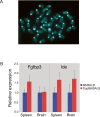Genomic copy number and expression variation within the C57BL/6J inbred mouse strain
- PMID: 18032724
- PMCID: PMC2134784
- DOI: 10.1101/gr.6927808
Genomic copy number and expression variation within the C57BL/6J inbred mouse strain
Abstract
The C57BL/6J strain is one of the most widely used animal models for biomedical research, and individual mice within the strain are often assumed to be genetically identical after more than 70 yr of inbreeding. Using a single nucleotide polymorphism (SNP) genotyping panel, we assessed if copy number variations (CNVs) could be detected within the C57BL/6J strain by comparing relative allele frequencies in first generation (F(1)) progeny of C57BL/6J mice. Sequencing, quantitative PCR, breeding, and array comparative genomic hybridization (CGH) together confirmed the presence of two CNVs. Both CNVs span genes encoded on chromosome 19, and quantitative RT-PCR demonstrated that they result in altered expression of the insulin-degrading enzyme (Ide) and fibroblast growth factor binding protein 3 (Fgfbp3) genes. Analysis of 39 different C57BL/6J breeders revealed that 64% of mice from the Jackson Laboratory colony were heterozygous for the CNV spanning Ide. Homozygotes with and without the duplication were present in concordance with Hardy-Weinberg equilibrium (13% and 23%, respectively), and analysis of archived samples from the C57BL/6J colony suggests that the duplication has rapidly reached a high frequency in the colony since 1994. The identification of two CNVs in the small portion of the genome screened demonstrates that individual mice of highly inbred strains are not isogenic and suggests other CNVs may be segregating within C57BL/6J as well as other carefully maintained inbred strains. These differences can influence interpretations of physiological, biomedical, and behavioral experiments and can be exploited to model CNVs apparent in the human genome.
Figures



References
-
- Bailey D.W. How pure are inbred strains of mice? Immunol. Today. 1982;3:210–214. - PubMed
-
- Churchill G.A., Airey D.C., Allayee H., Angel J.M., Attie A.D., Beatty J., Beavis W.D., Belknap J.K., Bennett B., Berrettini W., Airey D.C., Allayee H., Angel J.M., Attie A.D., Beatty J., Beavis W.D., Belknap J.K., Bennett B., Berrettini W., Allayee H., Angel J.M., Attie A.D., Beatty J., Beavis W.D., Belknap J.K., Bennett B., Berrettini W., Angel J.M., Attie A.D., Beatty J., Beavis W.D., Belknap J.K., Bennett B., Berrettini W., Attie A.D., Beatty J., Beavis W.D., Belknap J.K., Bennett B., Berrettini W., Beatty J., Beavis W.D., Belknap J.K., Bennett B., Berrettini W., Beavis W.D., Belknap J.K., Bennett B., Berrettini W., Belknap J.K., Bennett B., Berrettini W., Bennett B., Berrettini W., Berrettini W., et al. The Collaborative Cross, a community resource for the genetic analysis of complex traits. Nat. Genet. 2004;36:1133–1137. - PubMed
-
- Crabbe J.C., Wahlsten D., Dudek B.C., Wahlsten D., Dudek B.C., Dudek B.C. Genetics of mouse behavior: Interactions with laboratory environment. Science. 1999;284:1670–1672. - PubMed
-
- de Fourmestraux V., Neubauer H., Poussin C., Farmer P., Falquet L., Burcelin R., Delorenzi M., Thorens B., Neubauer H., Poussin C., Farmer P., Falquet L., Burcelin R., Delorenzi M., Thorens B., Poussin C., Farmer P., Falquet L., Burcelin R., Delorenzi M., Thorens B., Farmer P., Falquet L., Burcelin R., Delorenzi M., Thorens B., Falquet L., Burcelin R., Delorenzi M., Thorens B., Burcelin R., Delorenzi M., Thorens B., Delorenzi M., Thorens B., Thorens B. Transcript profiling suggests that differential metabolic adaptation of mice to a high fat diet is associated with changes in liver to muscle lipid fluxes. J. Biol. Chem. 2004;279:50743–50753. - PubMed
Publication types
MeSH terms
Substances
Grants and funding
LinkOut - more resources
Full Text Sources
Other Literature Sources
Molecular Biology Databases
